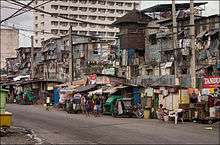Street children in the Philippines
According to a 1998 report titled "Situation of the Youth in the Philippines", there were about 1.5 million street children in the Philippines.[1]

Defining Filipino street children
According to the "A Better Life" foundation, there are three different categories of street children:
- Children on the streets make up approximately 75% of the street children in the Philippines. They work on the streets but do not live there. They generally have a home to return to after working, and some even continue to attend school while working long hours on the streets.
- Children of the street make their homes on the street. They make up 25%-30% of the street children in the Philippines. They often create a sort of family with their fellow street children. Some of them still have family ties, but may either rarely tend to them or view them negatively.
- Completely abandoned children have no family ties and are entirely on their own for physical and psychological survival. They make up approximately 5%-10% of the street children in the Philippines.[2][3]
Problems facing street children
Drugs
The most common substances are inhalants, such as solvents, rugby (a toluene-based glue) and cough syrups, followed by marijuana and shabu. Marijuana and shabus in particular are shared with friends whenever one of the group has enough money to buy them. Some street children take drugs as often as once a day.[2] A 1997 study estimated that up to 40% of street children had used drugs in the past. Other reports suggest that 66% to 85% of children had used inhalants, and 3% had used marijuana and shabu.[4]
Summary execution of street children
Many street children were in danger of summary execution during the Marcos Government era.[5] In 2005, a report found that 39 children in Davao City had been killed by vigilante groups since 2001, most after having been released from police detention cells.[6]
Child prostitution
Child prostitutes are used by foreign sex tourists and pedophiles, as well as local people. Some are used to film child pornography, which is rampant in the Philippines.[7] Many street children are lured into prostitution as a means of survival, while others do it to earn money for their families. A variety of different factors contribute to the commercial sexual exploitation of children in the Philippines.[8]
Rooted in poverty, as elsewhere, the problem of child prostitution in Angeles was exacerbated in the 1980s by Clark Air Base, where bars employed children who ended up as sex workers for American soldiers.[9] Street children are at particular risk because many of the 200 brothels in Angeles offer children for sex.[10] According to 1996 statistics of the Philippine Resource Network, 60,000 of the 1.5 million street children in the Philippines were prostituted.[11]
HIV/AIDS and STDs
There is no HIV testing for children in the Philippines, but approximately 18% of the street children contract sexually transmitted infections (STIs).[8]
NGO responses
Various organizations have established charities and shelters, providing counseling, food, clothing and religious instruction in an attempt to help street children. These include Street Contact For Children,[3] Subic Bay Children's Home,[12] LifeChild,[13] Spirit and Life Mission House, Tiwala Kids and Communities ,[14] Batang Pinangga Foundation, Inc (Cebu)[15]Jireh Children's Home,[16]He Cares Foundation,[17] ANAK-Tnk Foundation,[18] and the Tuloy Foundation, among others.
Notable street children
References
- "Street Children - Philippines". Retrieved 29 July 2015.
- "Teachers' Corner - Background(Detail)". Stairway Foundation. Archived from the original on February 27, 2009. Retrieved September 12, 2016.
- "The Life of Street Children in the Philippines and Initiatives to Help Them". Retrieved 29 July 2015.
- Njord, Levi; Merrill, Ray; Njord, Rebecca; Lindsay, Ryan; Pachano, Jeanette D. R. (May 10, 2010). "Drug Use Among Street Children and Non—Street Children in the Philippines". Asia-Pacific Journal of Public Health. 22 (2): 203–211. doi:10.1177/1010539510361515. PMID 20457649.
- "Preda Foundation, Inc. NEWS/ARTICLES: "Nobel Prize Nominee Lauded Around the World Deserted by His Own"". Archived from the original on August 31, 2009. Retrieved 29 July 2015.
- Capiloyan, Cleonante. "Globalization and Violence Against Children in the Philippines, 2005". Archived from the original (DOC) on August 23, 2006. Retrieved August 27, 2016.
- http://www.dw.com/en/the-philippines-booming-cybersex-industry/a-19026632
- "STREET CHILDREN IN THE PHILIPPINES.pdf" (PDF). Jubilee Action. Archived from the original (PDF) on June 12, 2004. Retrieved September 12, 2016.
- Agence France-Presse. "Pedophilia: Southeast Asia's sordid secret - INQUIRER.net, Philippine News for Filipinos". Inquirer.net. Archived from the original on April 2, 2015. Retrieved 29 July 2015.
- "BBC Politics 97". Retrieved 29 July 2015.
- "Philippines | Reading, wRiting, aRithmetic—and Child Rights". Inter Press Service. Archived from the original on February 2, 2008. Retrieved August 11, 2016.
- "Subic Bay Children's Home". Sbchome.org. Retrieved 2012-08-04.
- "LifeChild Asia Foundation Philippines Children's Homes". LifeChild Asia Foundation. Retrieved 15 February 2015.
- "Tiwala Kids and Communities| Christian Charity for street children Philippines". Tiwala.org. Retrieved 2012-08-04.
- "Home". Retrieved 15 February 2015.
- "Jireh Children's Home". pfmonline.org. Retrieved 2014-03-18.
- "He Cares Foundation Street Children Caring Center: Help the Poor in Metro Manila, Philippines". Retrieved 15 February 2015.
- "ANAK-Tnk Foundation, Giving Street Children A Second Chance At Life". www.anak-tnk.org. Retrieved 27 August 2016.